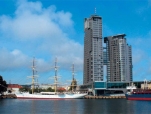Polish Exercises

Poland has always been particularly concerned with the problems of sovereignty and national identity. To enjoy the equal rights with the states of the Old Europe took the Poles centuries. Historically, their claims were neglected not only by their foes, but also by allies. Therefore Poland has persistently been trying to prove its “West European nature”, at the same time emphasizing the “independence”, and it has become the flesh and blood of this arrogant nation. Thus, the architecture, as a visual artistic expression of public expectations, consistently demonstrated interest in the subject of national and international, including the matter of high-rise construction. Each new tall landmark, in addition to its primary functions, always bears a lot of symbolic associations, and therefore the skyscrapers reflect general social trends.
As the city’s most visible landmark, The Palace of Culture and Science – a Stalinist skyscraper in Warsaw, was controversial from its inception. Construction started in 1952 and lasted until 1955. A gift from the Soviet Union to the people of Poland, the tower was constructed, using Soviet plans. The 42-story building is 231 metres tall which includes the height of the spire of 43 metres. The main architect Lev Rudnev incorporated some Polish architectural details into the project by traveling around Poland and seeing the architecture.
The monumental walls are headed with pieces of masonry copied from renaissance houses and palaces of Kraków and Zamość. Many Poles initially hated the building because they considered it to be a symbol of Soviet domination. Many visiting dignitaries toured the Palace, and it also hosted performances by notable international artists, such as a 1967 concert by the Rolling Stones, the first by a major western rock group behind the Iron Curtain. In 1985, it hosted the historical Leonard Cohen concert.
Furthermore, since Soviet domination over Poland ended in 1989, the negative symbolism of the building has much diminished. The terrace on the 30th floor, at 114 metres, is a wellknown tourist attraction with a panoramic view of the city. An old joke held that the best views of Warsaw were available from the building: it was the only place in the city from where it could not be seen.
The building currently serves as an exhibition centre and office complex containing cinemas, theatres, museums, offices, bookshops, a large conference hall for 3000 people, and an accredited university, Collegium Civitas on the 11th and 12th floors of the building. Four 6.3-metre clock faces were added to the top of the building in 2000, making it briefly the tallest, and now the world’s secondtallest, clock tower (after the NTT DoCoMo Yoyogi Building, to which a clock was added in 2002).
Full version you can download here
 Text by MARIANNA MAEVSKAYA
Text by MARIANNA MAEVSKAYA


